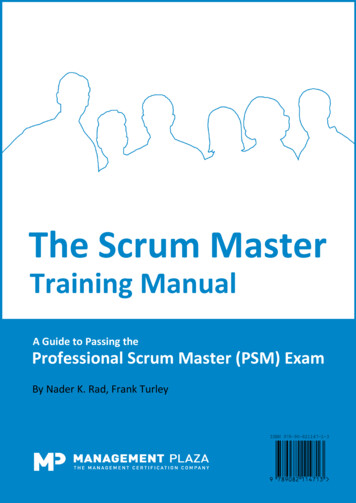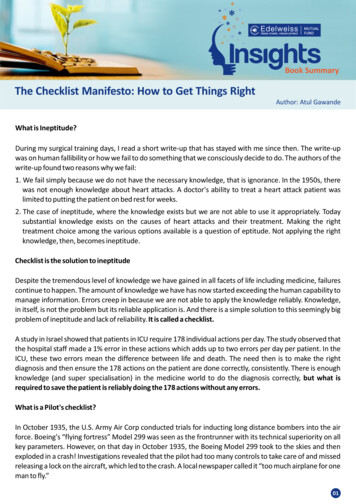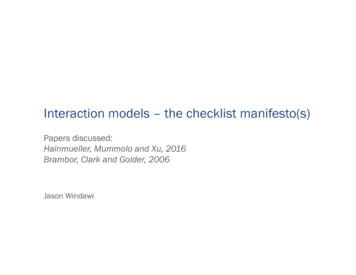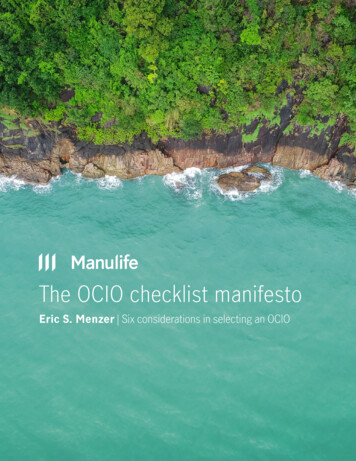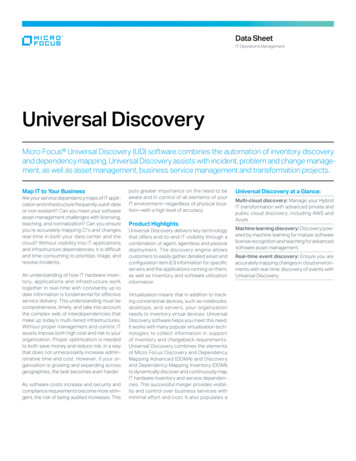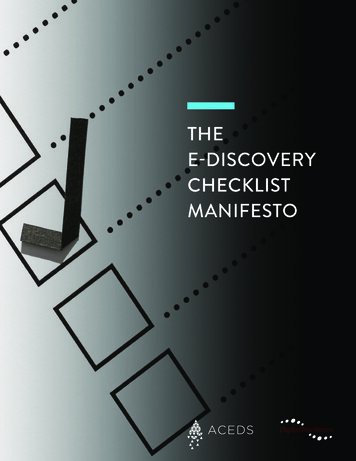
Transcription
THEE-DISCOVERYCHECKLISTMANIFESTOPAGE i ACEDS.ORG 2020 Digital WarRoom & Association Of Certified e-Discovery Specialists
AUTHORS:Tom O’Connor, Gulf Coast LegalTechnology CenterJeremy Greer, Digital WarRoomMichael Quartararo, ACEDSCONTENTSINTRODUCTION. 1The E-Discovery Checklist Manifesto Diagram.1CONSULTATION. 2Federal Rules: The Federal Rules of Civil Procedure (FRCP). 2Client Meeting Checklist. 3Review of Factual Issues. 3Information Governance Considerations. 3Strategy: Manage Expectations. 3IDENTIFICATION. 4Data Map. 4Sources of ESI. 4Non-Custodial Sources. 4Custodians. 5Strategy: Plan for Reasonableness. 5PRESERVATION. 6A Preservation Checklist. 6Implement a Litigation Hold. 6Strategy: Thoughtful and Reasoned Approach. 7COLLECTION. 8Forms of Collection. 8Collection Checklist. 8Strategy: Base Collection on the Needs of the Case. 8PROCESSING. 9What Happens During Processing?. 9A Processing Checklist. 9Strategy: Reduce the Data Set. 9DOCUMENT REVIEW.10Reviewing Techniques Are Used to Identify. 10Some steps to consider to maximize efficiency and organize the document review . 10Strategy: Consistency. 11ANALYSIS CHECKLIST. 12Strategy: Understand the Data. 12PRODUCTION CHECKLIST. 13Strategy: Quality Control.13ABOUT.14PAGE i ACEDS.ORG 2020 Digital WarRoom & Association Of Certified e-Discovery Specialists
INTRODUCTIONLitigation is complex, dynamic, and unpredictable. A good checklist is designed to be your guide in forming a consistent,repeatable process. From the moment litigation becomes imminent until a settlement or judgment, practitioners cannotafford to miss anything. Because of the high stakes of litigation, it is crucial to meet the necessary requirements to thecourt and zealously represent your client while managing time, budget, and risk. This manifesto will serve as a completee-discovery checklist covering the legal discovery process.The traditional Electronic Discovery Reference Model (EDRM) was developed in 2005 to provide practitioners with acommon framework for work in e-discovery. Today, smaller teams are tackling e-discovery projects and “do-it-yourself”solutions are available at affordable rates for the small to medium case. At the same time, practitioners in e-discovery areexpected to be technologically competent while the technology itself continues to evolve.Educational content must also evolve to encompass new technological requirements of practitioners in alignment withtheir traditional role of risk management, cost management, and time management. The authors recognize that theseresponsibilities constitute an iterative, nonlinear process. In this manifesto, we establish a comprehensive list of pointswhich form a more accurate depiction of the e-discovery lifecycle for the modern-day practitioner.THE E-DISCOVERY CHECKLIST MANIFESTO DIAGRAMUNIQUE TASKSThe diagram below is based in part on the EDRMdiagram. The outer circle represents unique stepswhile the inner circle represents more commonsteps which may occur at any point in the process.Like the EDRM, this is not a literal, linear or waterfallConsultationProductionmodel. The order of the stages are only importantconceptually. In reality, practitioners can cycleback to earlier steps at any time, refining theirapproach to gain a better understanding of thedata or as the nature of the matter changes. Thediagram is intended for discussion purposes, notAnalysisas a prescription for the one and only right way toCOMMON ach e-discovery.It is necessary, too, that strategic planning,cost, and risk management play a role in thee-discovery process. Included in the diagram belowPreservationRevieware recommended strategies, budget, and riskmanagement techniques that will enhance the use ofProcessingthe checklists.Given this context, all stages outlined in the diagramshould be considered at one or multiple points aspractitioners move through an e-discovery project.The goal of the checklist manifesto is to include achecklist associated with each stage.PAGE 1 ACEDS.ORG 2020 Digital WarRoom & Association Of Certified e-Discovery SpecialistsCollection
CONSULTATIONThere are legal issues and obligations that every practitioner should be aware of that guide the e-discovery process. It isnot necessary to know or to cite chapter and verse of the federal or applicable state rules, but practitioners will need tohave a basic understanding of civil procedure rules on the federal level or the state law equivalents.FEDERAL RULES: THE FEDERAL RULES OF CIVIL PROCEDURE (FRCP)Rule 1: Just, Speedy, and InexpensiveoThe FRCP should be utilized in manner to secure the just, speedy, and inexpensive determination of every actionand proceeding.Rule 11: Signing Pleadings, Motions and Representations to the CourtoAn attorney must sign every pleading, motion or other paper and certify it is the document is not presented forany improper purpose, that it pertains to the claims and defenses in the case and any factual contentions haveevidentiary supportRule 26(a): Initial DisclosuresoParties must automatically disclose, without a request, names of individuals who have discoverable information, acopy of or description of ESI supporting claims of defenses, a computation of damages claimedRule 26(b): Scope and ProportionalityoParties may obtain discovery of “any nonprivileged matter that is relevant to any party’s claim or defense andproportional to the needs of the case.”o“Information within the scope of discovery need not be admissible in evidence to be discoverable”oA party need not provide discovery of electronically stored information from sources that the party identifies asnot reasonably accessible because of undue burden or costRule 26(f): Conference of the Parties; Planning for DiscoveryoIn conferring, the parties must consider settlement, make or arrange for ESI disclosures; discuss any issues aboutpreserving discoverable information; and develop a proposed discovery planRule 26(g): Signing Disclosures and Discovery Requests and ObjectionsoAttorney or party must sign discovery requests and objections and certify they are complete and correct,nonfrivolous, not used for any improper purpose, and not unreasonable, burdensome or expensiveRule 34 - Form of Production and SpecificityoA party may serve on any other party a request for production of documents. This request must specify withreasonable particularity each item or category of items to be inspected.oAny objection to a document request must “state with specificity the grounds for the objection.”oThe request must also specify the form in which ESI is to be producedoElectronic documents will be produced as kept in the ordinary course of business or organized in categoriesresponsive to a requestoDocuments must be produced in a “reasonably usable form”ABA Model Rule 1.1 on Duty of CompetenceoComment 8: To maintain the requisite knowledge and skill, a lawyer should keep abreast of changes in the law andits practice, including the benefits and risks associated with relevant technology, engage in continuing study andeducation, and comply with all continuing legal education requirements to which the lawyer is subjectPAGE 2 ACEDS.ORG 2020 Digital WarRoom & Association Of Certified e-Discovery Specialists
CLIENT MEETING CHECKLIST:And there are additional consultation points that every practitioner should consider in initial discussions with the client.Client interviews should lay the foundation for Identification, Preservation and Collection, and the notion of informationgovernance should be a discussion had with each client as well.Consultation can occur at any time and should ideally occur before any specific litigation arises in order to adequatelyprepare the client in a proactive manner for issues that may arise should litigation occur. Consultation may then occurcyclically throughout any project and will flow into the strategy checklist set out further below.Consider these points when litigation becomes imminent:REVIEW OF FACTUAL ISSUES:oDiscuss with client the nature and substance of any imminent or actual legal claims and events leading to anyclaimsoIdentify dates of occurrenceoIdentify key people involved in eventsINFORMATION GOVERNANCE CONSIDERATIONS:oWhat are the document management systemso(DMS)?oWhat documents fall under a legal requirementsuch as HIPPA, banking, privacy regulations,Are there specific document types, technologyand/or training of personnel common to theinsurance, etc.?oclient’s business and the employees who will beinvolved in this discussion?Does the IT department keep a data map? If not,they should.oCan client provide a complete employeeoWhat systems for content creation exist?organizational chart with name, positions, businessoWhat hardware and software applications are inlocations; all linked to the data map.use?ooWhat is the current data management strategy?oDoes the client have any formal informationgovernance or data retention policies andConsider privacy considerations with HR peopleand discuss any and all document retention areaswhere privacy issues may applyoGather copies of all insurance coverageprocedures?documents, including policies and analysis ofoIf so, what are they and what tools are used?coverage for disputes that may arise. Don’t forgetoIf not, how do employees save, retrieve and sharepolicies on individuals including life insurancedocuments?policies that may have E/O or DI coverage.oWhat backup practices are in place?STRATEGY: MANAGE EXPECTATIONSA lawyer cannot provide a specific budget or pricing until the items in this checklist are considered and agreed upon. Wrapyour checklist conclusions into a timeline with action items and Project Management items from the Strategy section.Managing and controlling the consultation from the outset is a clear strategic planning goal.Budget: When budgeting in the consultation stage, practitioners need to consider the number of hours involved inconversations, meetings, and other interactions with the client and multiply those hours by applicable hourly rate to arriveat a projected cost.Risk: The biggest risk in this early stage is potentially overlooking a significant source of potentially relevant data. It canbe costly and time consuming to go back and perform re-work. Failure to identify or preserve relevant information can becostly as well.PAGE 3 ACEDS.ORG 2020 Digital WarRoom & Association Of Certified e-Discovery Specialists
IDENTIFICATIONThe goal of Identification phase is to identify potentially relevant sources of ESI which could include people and systems.One common way to do this is to create a data map. The sources of ESI and custodian information will also be crucial toissuing an effective litigation hold in the Preservation stage. The scope of potentially relevant data may be uncertain in theearly phases of a legal dispute, so after gathering insight from the initial client consultation and custodian interviews, thenext step is to figure out where relevant data resides and who has custody or control of that data.DATA MAPA successful electronic discovery project should include an accurate picture of the target company’s data sources. Thedata map will consist of all hardware and software deployed to accomplish routine tasks such as managing companyemail or creating data backups.Data maps tend to vary widely from organization to organization and even within separate units of a large company. Theidentification process will locate servers of all types with data of all types (e.g. file servers, collaboration servers, emailservers, web servers) as well as any data management systems (e.g., document management systems, financial systems,disaster recovery, and backup systems). The data map will also cover user-created data such as user home directories ordepartmental shared directories. It should also include BYOD (Bring Your Own Drive) sources such as laptops, tablets,smartphones, memory cards and access from home computers.Many of the sources of ESI will likely be tethered to individual users, but as will be seen, there are non-custodial sources ofESI as well.Here is a checklist of sources of potentially relevant ESI:SOURCES OF ESIoEmail systemsoCloud-based applicationsoText messaging systemsoDatabasesoSocial media applicationsoPersonal computers and laptopsoWebsites and web serversoMobile devices, smartphones and tabletsoCollaborative and messaging applicationsoExternal drives, flash media and network attached(e.g., Slack, Google Chat, Facebook Messenger,storageWhatsApp)oHome computersoFile servers (departmental and personaloBackup systemsdirectories)oLegacy systemsoVoicemail systemsoInternet of Things (IoT) or connected devicesoDocument management systemsoDocument Management System (DMS) (includingNON-CUSTODIAL SOURCESoMarketing & sales information systemsoProduct development, intellectual property anddocument naming conventions, how documentsresearch (including notebooks, patents, R&Dare saved and stored)odatabase, etc.)oCustomer Service / Help DeskHuman resource and personnel data (including HRoFinance, accounting and billing datapolicies and procedures)oLegal departmentoIT departmentPAGE 4 ACEDS.ORG 2020 Digital WarRoom & Association Of Certified e-Discovery Specialists
CUSTODIANSOrganizations should also begin the identification process by identifying the key players or custodians involved in theevents leading to any legal dispute. This requires some analysis of the following:oWho are all the possible custodians?oWhat is the reporting structure?oWho has access to what data?oWhat systems and applications do they use?oHow does each employee relate to each data source?Another way to approach the issue of custodians is to cast a broader net and conduct individual custodian interviews. Acustodian interview checklist would include at least the following inquiries:oNameoHow do you manage your email?oTitleoDo you use a personal device for work-relatedoContact informationoJob descriptionoPredecessoroDo you use a personal computer or laptop?oWhat software applications do you use?oWhere do you save any potentially relevantactivities?oinformation?documents?oDo you have a home computer with relevantoDo you have any paper documents that may berelevant?oDo you know anyone else who may have relevantinformation?Identify any folders, directories or other storagelocations?STRATEGY: PLAN FOR REASONABLENESSThe process of identifying ESI in discovery must viewed under a microscope of reasonableness. That is the standard fortesting whether the appropriate scope and steps were taken to identify ESI in litigation. Take reasonable and proportionalsteps to meet discovery obligations.Budget: Much like the consultation stage, the budget in the identification stage will consist largely of the hours devotedto working with a client organization to identify the sources of potentially relevant ESI.Risk: The risk of overlooking significant sources of ESI continues in the identification stage. That risk can be mitigatedusing the checklist above and thorough client meetings and comprehensive custodian interviews.PAGE 5 ACEDS.ORG 2020 Digital WarRoom & Association Of Certified e-Discovery Specialists
PRESERVATIONIdentifying custodians and sources of ESI is where the process begins, but the underlying legal responsibility here is toisolate and protect against the intentional or unintentional destruction of potentially relevant data. This process mustbe reasonable; proportionate; efficient and auditable. The phrase often used by practitioners is that this should be a“repeatable, defensible process.”The duty to preserve relevant data does not always flow from a litigation hold notice. It may arise under a common lawobligation, a statute or regulation. In Federal court, the obligation arises when the party has received notice that theevidence is relevant to litigation or when a party should have known that the evidence may be relevant to future litigation.The failure to preserve relevant ESI can result in sanctions under certain circumstances.Finally, remember that the duty to preserve is not the same as the directive to produce. Theoretically, preservation isbroad while production is more targeted. Begin with your strategy and work forward from there.A PRESERVATION CHECKLISTConfer with in-house/outside counsel and IToDetermine if relevant ESI is reasonably accessiblepersonneloConsider proportionality to issues in the caseoMeet with and plan with IT and records personneloIdentify and mitigate any potential spoliationoDetermine the scope of duty to preserveoConsider specific custodians and sources of ESIoIs there a relevant time frame?oSuspend any auto-delete or records dispositionoissuesosystemsopracticesoConsider departing employees or retiring ofSequester, lock or collect ESI and otherinformationReview backup procedures and impact onoContemplate additional custodial interviewspreservationIMPLEMENT A LITIGATION HOLDA litigation hold is a directive, usually in the form of a memorandum or letter, that directs individuals and leaders within anorganization to preserve information and tangible items that may be relevant to a legal dispute, investigation or regulatoryinquiry. Organizations might also need to put a litigation hold in place in response to an audit or subpoena.Federal statutes and rules are silent on the requirement to implement a litigation hold. The obligation arises underthe common law requirement that litigations preserve evidence. A litigation hold should be implemented any time anorganization becomes aware of or reasonably anticipates litigation. That means, as soon as reasonably practicable uponnotice of actual or imminent litigation, an organization should send a notice to the appropriate individuals directing themto preserve and not alter or delete any information that may be relevant to the subject matter.A preservation letter is a slight variation on a litigation hold. An organization or law firm might send a preservation letter,for example, to another party or a third party to request that they preserve certain ESI.PAGE 6 ACEDS.ORG 2020 Digital WarRoom & Association Of Certified e-Discovery Specialists
A checklist for creating a litigation hold should include the following:oA summary of the nature of the dispute, investigation or inquiryoA statement of the organization’s obligation to preserve potentially relevant informationoA statement that usual retention and disposition practices will be suspendedoA clear directive not to delete, alter or destroy any relevant informationoThe sources of potentially relevant ESI and documentsoThe types of ESI, documents or other materials to be preservedoInstructions on how to handle potentially relevant ESIoA section asking the recipient to acknowledge receipt of the hold noticeoThe right person to contact if there are any questionsoAn appropriately scoped distribution planSTRATEGY: THOUGHTFUL AND REASONED APPROACHImplementing a litigation hold does not end once the notice is sent. It is also necessary to track responses to the hold,follow up with custodians as needed, and to potentially add additional custodians and sources as the case develops. Alitigation hold can be an iterative process and it may be necessary to monitor the status of the hold or issue periodicreminders to custodians. And finally, a litigation hold should eventually be released.Budget: The budget related to preservation will revolve around the time and effort needed to physically preserve orsegregate potentially relevant ESI and then draft and implement a litigation hold.Risk: Failure to preserve is perhaps the greatest risk of any e-discovery project. If not properly preserved, data may bepermanently lost. It is also the most frequent reason that courts impose sanctions.PAGE 7 ACEDS.ORG 2020 Digital WarRoom & Association Of Certified e-Discovery Specialists
COLLECTIONCollection is the acquisition of potentially relevant ESI, including files, graphics, images, data and any other form of digitalinformation. Arguably the single most important aspect of collection is understanding how the ESI will later be used andcollecting the data in a way that best facilitates that use and the specific needs of the case.Generally, how ESI is collected will impact each successive stage of an e-discovery project. Therefore, it is necessary tofirst decide how the data will be collected.FORMS OF COLLECTION Full forensic collection – this is a formal and highly technical process that results in a forensically sound, bit-for-bitcopy of a data source (e.g., computer hard drive, server or other media). Targeted collection – this involves collecting only selected ESI from specific locations on a hard drive, server orother data source. A write-protecting hardware or software is used in a targeted collection to prevent the alterationof metadata during the collection process and each file is assigned a hash value to validate that it has not beenaltered during collection. Self-collection – this typically involves using informal tools to simply copy files and other ESI from one locationto another. This process might be used in less formal circumstances where strict rules of authentication and theadmissibility of evidence may not apply and where there is no need for forensic collection.There are many sources of potentially relevant ESI and varying methodologies for collecting that data. However, inmost instances, collecting user created content, whether it consists of email, word processing or spreadsheet files, oreven backup media, will deploy one of the three methods outlined above to collect the ESI. Even collecting web-basedand social media data is typically conducted in a forensic, targeted or informal manner. The best practice is to base thecollection on the needs of the case.COLLECTION CHECKLISToPlan and determine final scope of the collectionoPrepare list of custodians and data sourcesoConfer with IT personnel regarding access to datasourcesoDetermine collection typeoConfirm and schedule collectionoDetermine resources, tools and techniques foroPerform collection and validation of ESIcollectionoPrepare/obtain acquisition report/collection logoEngage resources to perform collectionoInitiate/obtain chain of custody documentationoCreate collection specification/statement of workoPrepare a status report for legal teamSTRATEGY: BASE COLLECTION ON THE NEEDS OF THE CASEIf ESI is not properly collected, it can have serious implications later in the case. It is best to focus a collection on relevantcustodians and sources of ESI and to focus on how the data will be filtered and culled in the next step, processing.Budget: The cost of a collection necessarily depends on the type of collection the volume of the data and the resources usedto perform the collection. While deploying teams of forensic examiners to perform extensive collection is going to be costly,there are tools and technologies that may be deployed to make collection less costly. Again, focus on the needs of the case.Risk: Potential pitfalls in collection include poor or improper collection techniques that may result in spoliation of data.Other risks include failure to properly catalog and validate that ESI has been collected properly to ensure metadata hasbeen preserved.PAGE 8 ACEDS.ORG 2020 Digital WarRoom & Association Of Certified e-Discovery Specialists
PROCESSINGAfter collection, it is necessary to “process” data to prepare it for review. The bulk of this stage is usually carried out asyou add or upload collections into an e-discovery software platform. The goals of processing are to first identify whatis in the data set and then to develop processes for filtering and culling the ESI to arrive at those documents that willbe promoted for actual review. To enable defensible reduction of data, practitioners will create fi
THE E-DISCOVERY CHECKLIST MANIFESTO DIAGRAM The diagram below is based in part on the EDRM diagram. The outer circle represents unique steps while the inner circle represents more common steps which may occur at any point in the process.

